Countertop Geology: Desperate for rocks? Visit a “granite” countertop store!
Where can you see some rocks? It’s winter and everything’s covered in snow –or you’re visiting family in some place where there’s virtually no bedrock exposed anywhere –or you’re simply stranded far from any good rocks in the center of a big city.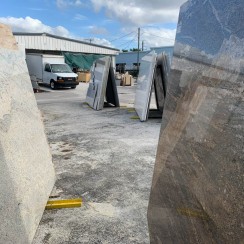
Take yourself on a field trip to a granite countertop store! You might not see very much real granite, but you will see some other types: folded gneiss, pegmatite, amphibolite, quartzite, maybe even some granite… and a lot of amazing metamorphic and igneous features and faults –and they’re all polished and none are covered by vegetation.
I needed a rock fix the other day while visiting my mother in SW Florida –so I drove to a granite countertop store. And wow— I saw all sorts of great stuff, a lot of which related to faulting and fracturing, and a lot of it could go right into a geology textbook. In Florida!
But first of all, the term “granite”. Countertop places call just about everything made of silicate minerals to be granite –and the other day, I didn’t see a bit of granite. Being an intrusive igneous rock, granite is generally pretty homogeneous in appearance, unlike metamorphic or sedimentary rocks, which tend to be banded or layered. (see this primer on rock types) Granite also has a specific chemistry, which translates to a pretty specific set of minerals: mostly orthoclase and plagioclase feldspars and quartz, with some white or black mica and maybe some amphibole thrown into the mix. As a result, granitic rocks tend to be pretty light-colored so there’s no such thing as a black granite –or a charcoal granite.

Some real granite –with quartz (Q), Orthoclase feldspar (O), Plagioclase feldspar (P), and the black mica Biotite (B).
The first rock I saw on my Florida field trip was this gently folded quartzite (notice how the two opposing slabs make it look more folded than it is). It’s chock full of dark zig-zaggy things called stylolites roughly parallel to bedding, many of which are offset along small fault zones. Stylolites form because some rocks partially dissolve when they’re under compressive stress; the actual stylolite consists of insoluble residue left behind after the dissolution occurs. You mostly see them in limestone because limestone’s pretty soluble. They’re actually pretty unusual in quartzites.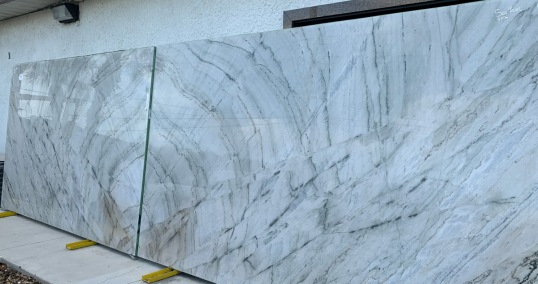
But what I found so instructive with this rock was the faulting. Look! With the 100% exposure, you can see how the apparent offset along the fault just below the penny diminishes as you go to the left. That’s an important feature about faults: their slip tends to die out towards their tips.
In this next photo of a granitic gneiss, you can see an igneous-filled fault offsetting the rock near the top, but it dies out completely as you go downward.

Then there’s the positively swirly biotite schist to the left with white blobs made of the rock pegmatite. It looks to me like the pegmatite once cut through the darker rock as a dike, and then got pulled apart and folded during some later time. Biotite-rich rocks tend to deform very easily whereas pegmatite tends to be pretty stiff, so the pegmatite retained some of its shape as it broke up while the rest of the rock flowed around it.
And serpentinite! Serpentinite forms by metamorphism of rocks from Earth’s mantle, so they tend to be comparatively poor in silica and rich in iron and magnesium. This serpentinite is highly altered to a pretty brown color (which makes this a prized countertop rock) –and you can see that alteration’s taken place along fractures –right where you’d expect high temperature fluids to circulate. And if you’re the type of geologist who really gets into fractures… well here you go: 100% exposure!
For me, this last example of a ductile shear zone might be the most helpful. I always have a difficult time describing these features to students because ductile shear zones are conceptually difficult; they’re basically faults without any breakage. As you can see in the photo, material got displaced in a sense roughly parallel to the arrows –but nothing got broken. The metamorphic layers simply bend into the zone and thin out and don’t really break. THAT is a ductile shear zone!
Of course, you could also wander into the downtown of a big city and see amazing facing stones too –or you could look at the awesome countertop in somebody’s kitchen –or see incredible polished rocks in bathroom sinks or as floor tiles –and those places are great too. But countertop “granite” places have many many more samples to ogle –the they also have a refuse bin. You might be able to take home some samples—and some of those might even be granite!
on an earlier trip to a “granite” store, I found an amazing metaconglomerate –and blogged about the metaconglomerate and geologic time. Please take a look!
Also, most of these pics are available for free download from the search function at my website: geologypics.com.

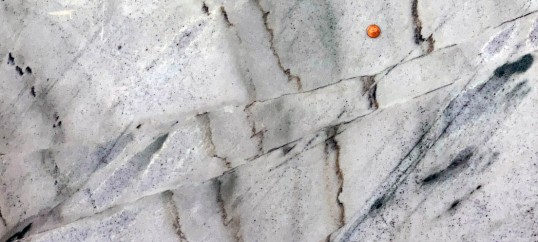


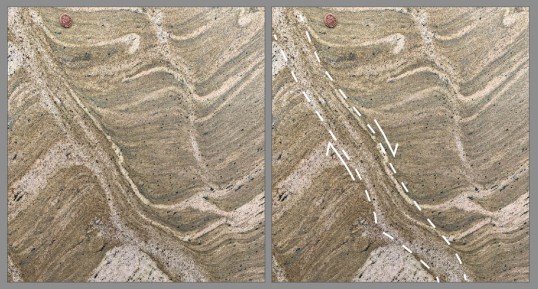
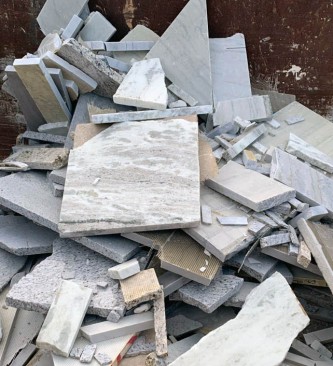
Beautiful. I have a “granite” hearthstone, that is actually a block of black basalt.
“That’s an important feature about faults: their slip tends to die out towards their tips.” Why? I had simple-mindedly imagined that if a fault is caused by one block moving relative to another, the offset should be constant. What have I failed to take into consideration?
LikeLike
Thanks Paul!
If you were to make a cut through a block and move one side along your nearly created fault, the amount of displacement would be constant along the entire length. But natural faults offset rock that’s not perfectly rigid –and their displacements are typically greatest near their centers. Many faults also die out along their lengths by small-scale faulting and fracturing, which helps alleviate the strain discontinuity.
LikeLiked by 1 person
Interesting! Thanks for the explanation, Marli. Like Paul, I envisioned the offset of the fault to be constant between slabs, but I can see how that cannot be due to energy transfer being diminished and absorbed along the way. Truly look forward to each post. Thanks for your blog!
LikeLiked by 1 person
This is great! My son opened a coffee shop one year ago on SE Foster & 69th, called Carnelian Coffee, because of his love of rocks and agates & thunder eggs. When I was helping him set up the shop, I thought a nice piece of granite countertop (used as a table top) be nice in the window of the shop. It was SO MUCH FUN going to different counter top stores around Portland, to find just the right thing. I finally found something that looks very similar to the granitic gneiss in your post, only more red. A customer baked a “geode cake” for the first year anniversary!
(I can’t attach photos to this comment, so I’ll email them to you. My son Luke and I came to your talk at the Science Pub at Mission Theatre, which we both loved! You can see some gorgeous agates and other rocks in the shop if you go to their FB page, or Instagram or Tumblr for “Carnelian Coffee”.)
LikeLike
My friends don’t understand my fascination with countertops. So beautiful, so exposed. I just can’t afford them in my own home!
LikeLiked by 1 person
I can relate on that! There are so many things to see –it can be totally distracting!
LikeLike
You can do the same in city marble facings and floors. Geol Soc in London does an annual field trip downtown that’s always oversubscribed (I never got in #groan)
LikeLike
Yes! It’s pretty amazing how these incredible, polished rocks, are so around us. Thanks for pointing that out!
LikeLiked by 1 person